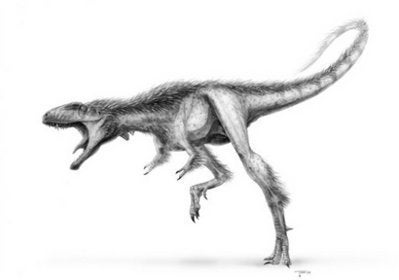
Millions of people come to the American Museum of Natural History each year to see dinosaurs for reasons that are obvious: they are strange, magnificent creatures, awesome in the true sense of the word, and it is fun to be dwarfed by them, marvel at their ferocity, and imagine the world they lived in. They also hold a vivid warning to us 21st Century folk, as we struggle to address the massive and vexing global issues of our time, like climate change, energy supply, the economy, emerging health threats and cultural conflict.
For reasons that are still not fully clear, some 65 million years ago nearly all dinosaurs, the dominant large animals on Earth, went extinct. But one dinosaur group was clearly adaptive enough to survive the environmental changes and developed into modern-day birds.
Science has a way of describing the rapid, explosive emergence of new species, which often follows mass extinction events like that of the dinosaurs. It is the evolutionary theory of "punctuated equilibrium." Proposed in 1972 by Niles Eldredge and the late Stephen Jay Gould, scientists working at the American Museum of Natural History, punctuated equilibrium holds that evolutionary change occurs not in a gradual, step-wise fashion but in spurts of intense and rapid evolutionary events in response to dramatic environmental pressure. Long periods of seeming stasis are punctuated by explosive change.
With so many issues seemingly at the boiling point at the same time in our global society and national life right now, we seem to be undergoing a period of punctuated equilibrium with considerable social change. Think health care. Think education. Think energy. Think the economy. The old, long-relied-upon systems for problem-solving are struggling under extreme pressure and are not necessarily up to the task.
Just as there have been moments of intense evolutionary spurts, there are precedents for this kind of social phenomenon. The industrial revolution was a relatively compressed period of explosive change in agriculture, industry, production and transportation. New kinds of jobs were created and others went "extinct," the middle class rose and the landed nobility began to decline in power. Those individuals who could learn new skills, adapt to new technologies, and even relocate thrived.
Both science and history teach us that the evolutionary stress to adapt to changing circumstance puts enormous pressure on complacency and rigidity. But it also provides great opportunity for those who can adapt, who can think and act in new ways, who can lead. If today, after many years of "business as usual," our society, our systems, and our institutions are all undergoing a kind of evolutionary burst, then how do we ensure that it yields change for the better? As in natural evolution, in social evolution there can and will be winners and losers -- institutions, industries, and even, perhaps, entire countries.
Charles Darwin wrote: "It is not the strongest of the species that survives, nor the most intelligent that survives. It is the one that is the most adaptable to change."
So adapt we must, as we are more deeply and intricately connected than ever before in history, not just as individuals, but as a vast global system. The problems we are now struggling to solve defy traditional geographic, political, economic, and technological boundaries and other manmade systems. The very systems that we have long relied on to address these issues are shifting under our feet and we must now construct a new architecture for national and global problem-solving.
There is now not only an opportunity but an imperative to seriously consider what conditions and approaches can best fuel progress in this new era. We may need to re-imagine the roles of society's pillars -- from universities, corporations, museums, and libraries to governments and non-governmental organizations -- and to revolutionize the working relationships among them. We should not only welcome and foster these changes but proceed with urgency and intentionality.
In time, we may view this moment as the true beginning of the new millennium when we began in earnest to throw off 20th Century ways of living and working, and commenced designing a new architecture for a new century.